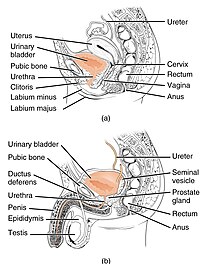
Photo from wikipedia
OBJECTIVE To examine the recent epidemiology of pediatric urinary stone disease (USD) in the United States. METHODS We utilized the 2004-2016 Optum© Clinformatics® Data Mart database, a de-identified adjudicated administrative… Click to show full abstract
OBJECTIVE To examine the recent epidemiology of pediatric urinary stone disease (USD) in the United States. METHODS We utilized the 2004-2016 Optum© Clinformatics® Data Mart database, a de-identified adjudicated administrative health claims database that includes 15-18 million individuals covered annually by commercial insurance in all 50 US states. The analysis included 12,739,125 children aged 0-18 years. We calculated annual rates of USD, ambulatory visits, and procedures, and the prevalence of prescription fills. RESULTS The 2005-2016 USD rate was 59.5 cases per 100,000 person-years. The annual rate rose gradually from 2005 to a peak of 65.2 cases per 100,000 person-years in 2011. The USD rate increased with increasing age, and was highest among females compared to males, non-Hispanic Whites compared to other race/ethnic groups, and those residing in the South compared to other geographic regions. The overall 2005-2016 rate in the 120 days following a USD episode was 1.9 for ambulatory visits, 0.24 for surgical procedures, and 1.1 for imaging procedures. Ureteroscopy was the most common surgical procedure and CT scan was the most common imaging procedures, although ultrasound utilization increased over time. Medications were filled in 46.9% of cases, and use was lowest among males (43.1%), Asians (34.8%), and in the Northeast (34.3%). Opiate agonists were the most prevalent prescription (39.9%). CONCLUSION Our study provides one of the most comprehensive examinations of pediatric USD to date, demonstrating shifting rates and treatment patterns over time, as well as differences by age, gender, race/ethnicity, and geographic region.
Journal Title: Urology
Year Published: 2019
Link to full text (if available)
Share on Social Media: Sign Up to like & get
recommendations!